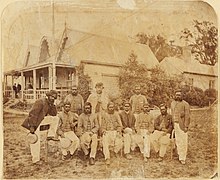History

A basic form of cricket can be traced back to the 13th century, but it may have existed even earlier than that. The game seems to have originated among children of the farming and metalworking communities in the Weald between Kent and Sussex. Written evidence exists of a game known as creag being played by Prince Edward, the son of Edward I (Longshanks), at Newenden, Kent in 1300.
In 1598, a court case referred to a sport called kreckett being played at the Royal Grammar School, Guildford around 1550. The Oxford English Dictionary gives this as the first recorded instance of cricket in the English language.
A number of words are thought to be possible sources for the term cricket. The name may derive from a term for the cricket bat: old French criquet (meaning a kind of club) or Flemish krick(e) (meaning a stick) or in Old English crycc (meaning a crutch or staff). (The latter is problematic, since Old English 'cc' was palatal in pronunciation in the south and the west midlands, roughly ch, which is how crycc leads to crych and thence crutch; the 'k' sound would be possible in the north, however.) Alternatively, the French criquet apparently derives from the Flemish word krickstoel, which is a long low stool on which one kneels in church and which resembles the long low wicket with two stumps used in early cricket.
During the 17th century, numerous references indicate the growth of cricket in the south-east of England. By the end of the century, it had become an organised activity being played for high stakes and it is likely that the first professionals appeared in that period. We know that a great cricket match with eleven players a side was played for high stakes in Sussex in 1697 and this is the earliest reference we have to cricket in terms of such importance.
- See also: History of cricket to 1696 and History of cricket 1697–1725
The game underwent major development in the 18th century and had become the national sport of England by the end of the century. Betting played a major part in that development and rich patrons began forming their own "select XIs". Cricket was prominent in London as early as 1707 and large crowds flocked to matches on the Artillery Ground in Finsbury. The Hambledon Club was founded in the 1760s but its team was already playing first-class matches in 1756. For the next 20 years until the formation of MCC and the opening of Lord's in 1787, Hambledon was the game's greatest club and its focal point. MCC quickly became the sport's premier club and the custodian of the Laws of Cricket.
- See also: History of cricket 1726 - 1815 and History of cricket 1726–1815
The 19th century saw underarm replaced by first roundarm and then overarm bowling. Both developments were accompanied by major controversy. The concept of a "champion county" arose in the 1820s and then, starting with Sussex CCC in 1839, county clubs were founded and these ultimately formed a County Championship.

In 1859, a team of England players went on the first overseas tour (to North America) and 18 years later another England team took part in the first-ever Test match at the Melbourne Cricket Ground against Australia.
The legendary W G Grace started his long career in 1864. It can fairly be said that he revolutionised the sport and did much to ensure its massive popularity.
The last two decades before the First World War have been called the "Golden Age of Cricket". It is almost certainly a nostalgic idea based on the sense of loss brought about by the war, but even so the period did produce some great players and memorable matches, especially as organised competition at county and Test level developed.
The inter-war years were dominated by one player: Don Bradman, statistically the greatest batsman of all time. It was the determination of the England team to overcome his incredible skill that brought about the infamous Bodyline series in 1932/33.
Cricket entered an epochal era in 1963, when English counties modified the rules to provide a variant match form that produced a certain result: games with a restricted number of overs per side. This gained widespread popularity and resulted in the birth of One-Day International (ODI) matches in 1971. The governing International Cricket Council quickly adopted the new form and held the first ODI Cricket World Cup in 1975. Since then, ODI matches have gained mass spectatorship, at the expense of the longer form of the game and to the consternation of fans who prefer the longer form of the game.
As of the early 2000s, however, the longer form of cricket is experiencing a growing resurgence in popularity but a new limited overs phenomenon, Twenty20, has made an immediate impact.
No comments:
Post a Comment